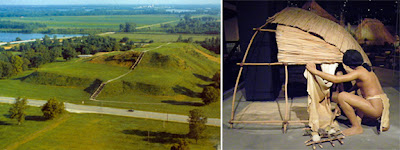• A
highway is defined as “a public road; a way open to all passengers; so called,
because it is a great or public road
• A
road is defined as “an open way or public passage; generally applied to
highways"
• A
path is defined as “a way beaten or trodden by the feet of man or beast—applied
to the ground only, never to a paved street in a city"
• A
trail is defined as “a track followed by a hunter; to tread down grass by
walking through it"
It
is interesting in Joseph Smith’s translation of the plates, he chose the word
“highway” rather than road when referring to the routes between cities in the
Land of Promise. The word “road” in Joseph’s era tended to describe dirt
streets through towns and country lanes. However, the word “highway” referred
to a major artery, generally one between cities, with a high level of traffic,
and typically paved in one manner or another.
Roman
Roads Left: Ancient Highway in
Thessalonica, Greece; Right: Ancient highway in the Middle
East in the time of Lehi, from Egypt through the Sinai to the Gulf of Aqaba,
and then north of Syria
Perhaps
this is because the highways built in the Land of Promise by the Nephites were
extensive and connected all parts of the nation, including the different lands,
the different cities, and many places together in one major, highway
system. These highways were not just
between cities, but within the cities as well.
Helaman's son Nephi "...had a tower in his garden, which was by the
highway which led to the chief market which was in the city of Zarahemla" (Helaman
7:10).
In
fact, these highways were very extensive. As late as 29 A.D., the highway
system had reached a peak of building and connecting the various parts of the
nation together: "And there were
many highways cast up, and many roads made, which led from city to city and
from land to land, and from place to place” (3 Nephi 6:8). Since they were highways, they were obviously
more than merely leveled earthen tracks.
It
is not difficult to understand that this effective and efficient highway system,
when coupled with the Nephite ability in building and commerce, that the
importance of these highways, especially in a land that was as extensive as the
scriptures indicate, were critical and important arteries connecting the nation.
These were not trails, dirt roads, paths or lanes, but a system of highways
connecting the entire Nephite nation as indicated in 3 Nephi, both before and
after the catastrophic events at the Savior’s death. Helaman predicted this
event when he wrote of this coming destruction: “And many highways shall be broken
up, and many cities shall become desolate" (Helaman 14:4).
Then,
about five years later the terrible destruction came and the roads and highways
were destroyed: "And the highways
were broken up, and the level roads were spoiled, and many smooth places became
rough" (3 Nephi 8:13). Sometime during the last half of the first century
A.D., the Nephites rebuilt the cities that could be renewed (4 Nephi 1:7-9)
which, obviously would have included their highway system that enabled the
Nephites during their two hundred year golden age from 33 A.D. to 231 A.D. to
flourish in such a magnificent manner.
This
highway system, “which led from city to city and from land to land, and from
place to place” throughout the Land of Zarahemla and the Land of Bountiful and,
no doubt, in the Land Northward, would have been one of the most magnificent
building achievements the Nephites accomplished.
Yet,
the question begs: “Where are the remnants of that magnificent highway system
evident today.
Roman
Roads: Left: Horvat Hanut along the ancient road ascending from the Elah
valley, a part of the Roman road from the coast city of Ashkelon, via
Beit-Guvrin, to Bethlehem and Jerusalem; Right: The ancient rock-cut Roman road
Ma'ale-Akrabim, one of the spice route passes in the Negev desert
It
is interesting that the famed Roman Roads, which spanned about 250,000 miles
across Italy and around the Mediterranean, built from 500 B.C. to about 400
A.D.—about the same time of the Nephite roads—and are still in evidence today
in numerous areas. Obviously, then, some evidence of the Nephite roads would be
found in the Land of Promise today.
Where
are they in the Western Hemisphere? Only two places can roads of any type
dating to the time frame involved be found, and only in one place are those
roads equal to the building capability described in the Book of Mormon.
And
they are not in the United States!
(See the next post, “Where Are the Highways? Part II,” to see where the Nephite highway system is found—and first discovered by the Spaniards who saw them when they first arrived in the New World)













